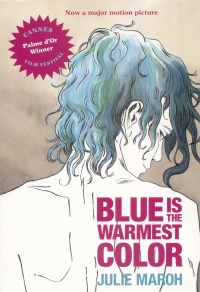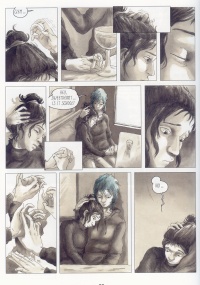| ________________
CM . . . . Volume XX Number 3 . . . . September 20, 2013
excerpt:
This graphic novel was originally written in French and published in 2010, then was adapted into an award-winning film in 2013, then the graphic novel was translated into English and republished in 2013 by Arsenal Pulp Press. It is a coming-out, coming-of-age queer love story between Clementine and Emma. The cover blurb describes it as "a tender, bittersweet, full-color graphic novel about the elusive reckless magic of love." While the book is both tender and bittersweet, the primary way I'd describe it is as melodramatic. That said, I would recommend this book strongly for teenagers, especially queer teenagers looking for their first representations of queer love and relationships. It's vital that young queers can find representations of queer sexualities in a wide range of media – a readable and sexy graphic novel, however flawed, is a windfall for a young reader.
The story the novel tells is one that has been told many times: girl meets girl, girl is angsty over same-sex attraction, girl has angsty/romantic relationship with girl, girls have difficult coming out interactions with parents, girl dies under dramatic circumstances. As an adult queer reader, I found this narrative predictable, but it probably would not feel so clichéd for young adults as they are likely to not have had as much experience with LGBT fiction as an adult reader. However, I was very disappointed that the novel fulfilled the long-standing YA fiction tradition of killing off one of the LGBT characters – Emma clutches her dying girlfriend's hand and cries to the doctor "There must be something you can do to save her!!" (p. 148). I want young adult novels to tell stories about a future for queers other than premature death. I was also disappointed that the story focused on queers being unhappy and emotionally tortured; the part where the novel skips 11 full years of the characters in a happy relationship was very telling. It moves directly from Clementine being violently cast from her parents' home when they discover her sexuality to Clementine being violently cast from her lover's home 30 years later. Emma cries, "You couldn't have done anything worse to break my heart!" as she physically tosses Clementine out of the door (p. 135). The book dares not show lesbians being happy, respectful of each other's needs, faithful, mature, etc. The film based on the graphic novel was criticised for its explicit sex scenes. The author released a statement saying that the sex scenes were like that of mainstream "lesbian" pornography made by and for straight people. She describes them as "a brutal and surgical display, exuberant and cold, of lesbian sex, which turned into porn, and made me feel very ill at ease" (http://www.juliemaroh.com/2013/05/27/le-bleu-dadele/). In contrast, in my opinion the graphic novel's detailed sex scenes are one of the best elements of the text. I imagine many teenage readers would find these scenes erotic and pleasurable to read, which is a strength of the text. I know my teenage self would have enjoyed them! If young people want to see lesbian sex, they have many easily available methods of doing so. Reading this novel is a better option than Googling "lesbian sex," which would unearth the kind of "lesbian" porn Maroh criticises. The sex in the novel is consensual and mutually pleasurable. The first time the characters have sex, Emma stops Clementine from going down on her and checks in if Clementine is feeling comfortable, saying "No, wait. You've never done it before" (p. 96). After some discussion, they continue with different sexual activities. The book models consent and communication in a way internet porn rarely does. The novel also depicts the emotional messiness of actual sex – the participants are fairly three-dimensional people, with histories and social contexts. Once after sex they have a conversation about communication within a relationship: Clementine says, "Hey, Emma, I'm not going to get up and leave like that, just because we said how we felt" (p. 112). If we want young people to go on to have mutually pleasurable and consensual sex, and treat their partners with respect, reading this novel is a better preparation than watching readily available internet porn with its strangely de-contextualised participants. Julie Maroh both wrote and illustrated the graphic novel. Her illustrations are attractive watercolours, mainly black and white, but with occasional muted colours, most noticeably in Emma's symbolic blue hair. While strictly representational, they are fluid and use light and shadow well. The strength of the images lies in the way they transmit and enhance emotion which is appropriate for this dramatic novel. On the whole, the images simply make visual the events of the narrative. The graphic novel would have been more compelling if Maroh had experimented more with layout and other visual tools to interact with the written text in more complex ways. I'd like to close this review by mentioning a Canadian lesbian graphic novel for young adults which came out in 2008: Skim, written by Mariko Tamaki and illustrated by her cousin Jillian Tamaki. The plot of this novel is layered and interesting, the narrative voice is clever and cutting (and often very funny), and the illustrations are beautiful and thoughtfully constructed, both complicating and offering much additional meaning to the story. I would strongly recommend readers check out Skim in addition to, or even instead of, Blue is The Warmest Colour. That said, Blue Is The Warmest Colour is a worthwhile addition to any library whose readers include teenagers exploring their sexuality – that is, all of them. Highly Recommended. Lian Beveridge is a PhD graduate from the University of British Columbia. Her primary research interests are children's literature and queer theory.
To comment
on this title or this review, send mail to cm@umanitoba.ca.
Copyright © the Manitoba Library Association. Reproduction for personal
use is permitted only if this copyright notice is maintained. Any
other reproduction is prohibited without permission.
NEXT REVIEW |
TABLE OF CONTENTS FOR THIS ISSUE
- September 20, 2013.
AUTHORS |
TITLES |
MEDIA REVIEWS |
PROFILES |
BACK ISSUES |
SEARCH |
CMARCHIVE |
HOME |

 Blue Is The Warmest Colour is angst-ridden to the point of melodrama. While wearing for an adult reader, this emotional tone is not inappropriate for a teen romance – when I was a young queer, myself, I would have found it gripping and moving. However, the intense emotional content is based on a thin plot. The main narrative tension of the text is 15-year-old Clementine's tension about being attracted to women. After one of her first meetings with Emma, Clementine writes: "I feel lost, and I can't talk about things as twisted as that with my friends – they'll hate me. [. . .] I'm a girl, and girls date boys" (p. 20). Later, she agonises over her physical attraction to Emma, writing of her "desire to be in her arms, to caress her, to kiss her" and then the way "shame takes over, and I hate myself, and I bury myself in the ball of fire that is screaming to get out of my guts" (p. 83). While I recognise that realising same-sex attraction can be a difficult experience, especially if one is a young person with homophobic parents, I wanted the story to contain more. The level of emotional intensity would have been more engaging and plausible if it were tied to a more complex plot or one which engaged with bigger issues. In addition, the novel tends to simply depict the characters being tormented, without really delving into why, or offering any solutions or productive ways to conceptualise the issues with which they are struggling. Maroh began writing the book as a teenager, and this perspective is still present in the scope and focus of the novel.
Blue Is The Warmest Colour is angst-ridden to the point of melodrama. While wearing for an adult reader, this emotional tone is not inappropriate for a teen romance – when I was a young queer, myself, I would have found it gripping and moving. However, the intense emotional content is based on a thin plot. The main narrative tension of the text is 15-year-old Clementine's tension about being attracted to women. After one of her first meetings with Emma, Clementine writes: "I feel lost, and I can't talk about things as twisted as that with my friends – they'll hate me. [. . .] I'm a girl, and girls date boys" (p. 20). Later, she agonises over her physical attraction to Emma, writing of her "desire to be in her arms, to caress her, to kiss her" and then the way "shame takes over, and I hate myself, and I bury myself in the ball of fire that is screaming to get out of my guts" (p. 83). While I recognise that realising same-sex attraction can be a difficult experience, especially if one is a young person with homophobic parents, I wanted the story to contain more. The level of emotional intensity would have been more engaging and plausible if it were tied to a more complex plot or one which engaged with bigger issues. In addition, the novel tends to simply depict the characters being tormented, without really delving into why, or offering any solutions or productive ways to conceptualise the issues with which they are struggling. Maroh began writing the book as a teenager, and this perspective is still present in the scope and focus of the novel.